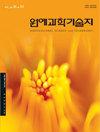富士/M.9双轴苹果园树形配置嫁接植物-树木生长和生产力在早期根据种植距离
IF 0.8
4区 农林科学
Q3 HORTICULTURE
Korean Journal of Horticultural Science & Technology
Pub Date : 2023-10-31
DOI:10.7235/hort.20230048
引用次数: 0
摘要
本研究是在一个双轴苹果园中进行的,不同的种植距离(行距和行内间距分别为3 m×1.5 m和1.2 m, 1.0 m, 0.8 m),使用' Fuji ' / m。在果园生命周期的早期(种植后长达四年),通过9个嫁接来控制树木的形状,并根据种植距离比较树木的生长结果和初始产量。窄冠宽双轴树形的配置需要在生长季节对枝条进行修剪,8月后去除水芽或与主茎竞争的枝条,冬季缩短过长/过粗的枝条或更新修剪。在建园初期,随着种植密度的增加,营养生长下降,而刺型结果枝的形成有增加的趋势。种植第4年时的截光率为37 ~ 42%,不同种植方式间无差异。种植距离为1.5 m、1.2 m、1.0 m和0.8 m时,累积产量分别为8.7、9.3、9.9和10.3 kg/株。产量随种植距离的减小而增加。综上所述,双轴果园树形结构中树枝的弯曲是不必要的。直到双轴苹果园建立第四年,随着种植密度的增加,营养生长下降,有利于果实形成,单株累积产量增加。当种植距离为0.8 m时,树木活力略有下降。本文章由计算机程序翻译,如有差异,请以英文原文为准。
Configuration of the Tree Shape in a Bi-axis Apple Orchard using ‘Fuji’/M.9 Grafted Plants – Tree Growth and Productivity during Early Years According to the Planting Distance
This study was carried out in a bi-axis apple orchard with various planting distances (between- and within-row spacing at 3 m×1.5 m and 1.2 m, 1.0 m, 0.8 m, respectively) using ‘Fuji’/M.9 grafts to manipulate the tree shape during the early years of the orchard’s lifespan (up to four years after planting) and to compare tree growth outcomes and initial yields according to the planting distance. The configuration of a bi-axis tree shape with a narrow canopy width requires pinching of the shoots during the growing season, the removal of water sprouts or branches competing with the main stem after August, and the shortening of overly long/thick branches or renewal pruning in winter. In the early years of orchard establishment, vegetative growth decreased as the planting density increased, whereas the formation of spur-type fruit-bearing branches tended to increase. The light interception during the fourth year of planting was 37–42%, and there were no differences between the planting methods. The cumulative yields (kg/tree) were 8.7, 9.3, 9.9, and 10.3 at planting distances of 1.5 m, 1.2 m, 1.0 m, and 0.8 m, respectively. The yield increased with a decrease in the planting distance. In conclusion, the results here suggest that the bending of branches during the configuration of the tree shape in bi-axis orchards is not necessary. Until the fourth year of the establishment of the bi-axis apple orchard, with an increase in the planting density, the vegetative growth decreased, favoring fruit formation and an increased cumulative yield per tree. At a planting distance of 0.8 m, however, tree vigor was reduced slightly.
求助全文
通过发布文献求助,成功后即可免费获取论文全文。
去求助
来源期刊
CiteScore
2.00
自引率
0.00%
发文量
0
审稿时长
1 months
期刊介绍:
Horticultural Science and Technology (abbr. Hortic. Sci. Technol., herein ‘HST’; ISSN, 1226-8763), one of the two official journals of the Korean Society for Horticultural Science (KSHS), was launched in 1998 to provides scientific and professional publication on technology and sciences of horticultural area. As an international journal, HST is published in English and Korean, bimonthly on the last day of even number months, and indexed in ‘SCIE’, ‘SCOPUS’ and ‘CABI’. The HST is devoted for the publication of technical and academic papers and review articles on such arears as cultivation physiology, protected horticulture, postharvest technology, genetics and breeding, tissue culture and biotechnology, and other related to vegetables, fruit, ornamental, and herbal plants.

 求助内容:
求助内容: 应助结果提醒方式:
应助结果提醒方式:


